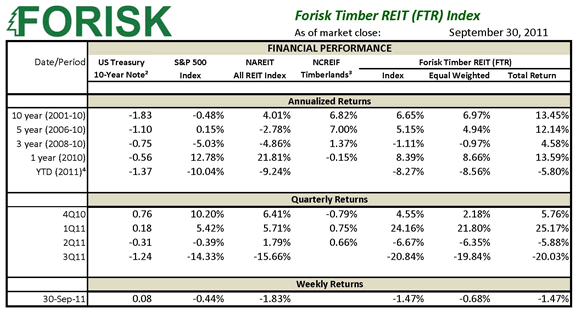With uncertainty in Europe, tight credit markets and falling projections for demand for commercial office space and residential construction, The Wall Street Journal published a profile of the REIT sector that summarized the “dethroning” of REITs as a preferred equity category by investors (“Investors check out of real-estate stocks”, October 5, 2011). Of note, REITs that manage hotels and industrial space fell 32% and 24% during the third quarter of 2011. How did this sector-wide “slap down” affect timberland-owning REITs?
Timber REITs Fall with the Sector
While publicly-traded timberland-owning REITs, and REITs generally, outperformed the S&P 500 over 10-year, 3-year and 1-year benchmarks (see table), the timber REIT sector took a shellacking during the quarter. The timber REIT sector, as measured by the FTR (Forisk Timber REIT) Index, returned -20.84% for the quarter, and sits at -8.27% year-to-date.

Individually, the four publicly-traded timber REITs produced varying returns for the quarter, with Weyerhaeuser leading the way down, and Potlatch holding its own on a relative basis:
- Potlatch (PCH): -10.63%
- Plum Creek (PCL): -14.38%
- Rayonier (RYN): -15.55% (split adjusted)
- Weyerhaeuser (WY): -28.87%
Weyerhaeuser drove timber REIT returns as it comprises 44% of the market capitalization weighted FTR Index. Mathematically, the drop in share prices proved advantageous to investors shopping for dividend yields as Weyerhaeuser’s yield approached, and temporarily exceeded, 4%. Yields for Potlatch continue to exceed 6%, while Plum Creek and Rayonier hover between 4 to 5%. The question becomes the sustainability of dividend levels given the outlook on core revenue generators for these firms. Our research targets the ability of current cash generators by firm to satisfy cash obligations (i.e. debt service and dividends) in the near and mid-term.
Looking forward, the sector suffers from downward revisions associated with housing demand and construction in the United States, and the associated declining need for softwood lumber manufactured from the pine, Douglas-fir and hemlock trees grown by the timber REITs. Alternately, the Performance Fibers and log export businesses have provided timely and opportunistic lifts to revenues.
This content may not be used or reproduced in any manner whatsoever, in part or in whole, without written permission of LANDTHINK. Use of this content without permission is a violation of federal copyright law. The articles, posts, comments, opinions and information provided by LANDTHINK are for informational and research purposes only and DOES NOT substitute or coincide with the advice of an attorney, accountant, real estate broker or any other licensed real estate professional. LANDTHINK strongly advises visitors and readers to seek their own professional guidance and advice related to buying, investing in or selling real estate.










Timing is everything and with the current housing situation we are a good ways from a bottom so the financial state of several of these suggests significant reason to hold off on these stocks until their prices drop significantly or profitability improves significantly. Fad investing has pumped a lot of dollars into these four REITS and one highly touted MLP.
Figures from Morningstar as of midday 9/22/11
—> RYN (-REIT-) – Wins the long term prize. However, EV/FCF (26) is ok and P/E (19) is a little rich for purchase right now. Div Yld 3.9%, 5yr Div Growth 4%, Payout Ratio 74%, 1.1% Insider Holdings, 45% Debt/Equity, 5yr ROA 10% are all ok or better.
—> POPE (-MLP-) – EV/FCF (14) is good but a P/E of 19 is a little rich for purchase right now and a Div Yld 2.5% combined with a 5yr Div Growth of -3% isn’t too inspiring. A Payout Ratio of 46%, 60% Debt/Equity are acceptable. 27.8% Insider Holdings is great and a 5yr ROA 6% is ok.
—> PCH (-REIT-) – With a 6.4% dividend yield and 28% 5 year dividend growth rate it might look like the best buy now but when Dividend Payout Ratio is 190% of Earnings and Debt/Equity is 1.87 I tend to loose any interest especially when we have 2 to 3+ years to go before housing returns to average. EV/FCF (13) looks good but a P/E of 29 is more than a little rich for purchase right now. 1.6% Insider Holdings and an ROA of 6% are just ok.
—> PCL (-REIT-) – With a 4.7% dividend yield and 2% 5 year dividend growth rate it might look like a decent buy now but when Dividend Payout Ratio is 157% of Earnings and Debt/Equity is 1.56 I get nervous when we have 2 to 3+ years to go before housing returns to average. EV/FCF (25) isn’t bad but a P/E of 33 takes it out of consideration for right now. 0.3% Insider Holdings is definitely not inspiring and a 5yr ROA of 6% is just ok.
—> WY(-REIT-) – With guts, and if you just have to jump into the forestry sector right now, this may be the current long term buy if you believe in a turnaround situation and are willing to wait a couple of years before that shows up. The P/E of 5.6 is it’s strong suite. EV/FCF is a dismal 129. Div Yld 3%, 5yr Div Growth -28%, aren’t great but a Payout Ratio of 14% would seem to indicate that they know they have to conserve cash to survive the next few years. 1.6% Insider Holdings, 95% Debt/Equity, 5yr ROA of 1% (ttm is 10%) are certainly not worth writing home about.